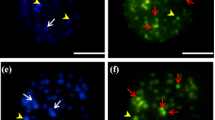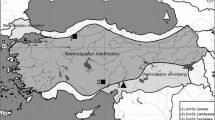Abstract
Populations belonging to the XO and neo-XY races of P. cucullata have been analysed with C-banding and fluorescent DNA-binding dyes. The extent of C-heterochromatin variation was found to be considerably greater than that described in previous papers. Most of the heterochromatinized regions are GC-rich and could be derived from the GC-rich sequences of the NORs. Since the gain of heterochromatin does not involve detectable modification of the chromosome size, the heterochromatinization process may be considered as an example of euchromatin transformation. On the other hand, the distribution of heterochromatin in the sex chromosomes seems to be markedly non-random, probably due to the selective advantage of a complementary distribution between neo-X and neo-Y chromosomes.
Similar content being viewed by others
References
Dover, G., 1982. Molecular drive: a cohesive mode of species evolution. Nature 299: 111–117.
Fernández-Piqueras, J., Rodriguez Campos, A., Sentís, C. & Wandosell, F., 1982. Pycnogaster cucullata (Charp.): a polytypic species of Tettigonioidea with XO and new XY sex determination. Heredity 48: 147–150.
Fernández-Piqueras, J., Rodriguez Campos, A., Sentís, C. & Rojo, E., 1983. Sex chromosome evolution in the polytypic species Pycnogaster cucullata. Heredity 50: 217–223.
Jones, K. W., 1984. The evolution of sex chromosomes and their consequences for the evolutionary process. In: M. Bennett, A. Gropp & U. Wolf (eds.), Chromosomes Today 8: 241–255.
Jones, K. W. & Singh, L., 1985. Snakes and the evolution of sex chromosomes. TIG, February: 55–61.
King, M., 1980. C-banding studies on Australian hylid frogs: secondary constriction structure and the concept of euchromatin transformation. Chromosoma 80: 191–217.
Schweizer, D., 1980. Fluorescent chromosome banding in plants: applications, mechanisms, and implications for chromosome structure. In: D. R. Davies & R. A. Hopwood. (eds.), Proc. 4th John Innes Symposium, Norwich, 1979. The plant genome. John Innes Charity: 61–72.
Schweizer, D., Mendelak, M., White, M. J. D. & Contreras, N., 1983. Cytogenetics of the parthenogenetic grasshopper Warramaba virgo and its bisexual relatives. X. Patterns of fluorescent banding. Chromosoma 88: 227–238.
Sentís, C., Rodriguez Campos, A., Stockert, J. C. & Fernández-Piqueras, J., 1984. Morphology of the axial structures in the neo-XY sex bivalent of Pycnogaster cucullata (Orthoptera) by silver impregnation. Chromosoma 90: 317–321.
Sumner, A. T., 1972. A simple technique for demonstrating centromeric heterochromatin. Expl Cell Res. 75: 304–306.
White, M. J. D., 1973. Animal cytology and evolution. 3rd ed. University Press, Cambridge.
Author information
Authors and Affiliations
Rights and permissions
About this article
Cite this article
Sentis, C., Fernandez-Piqueras, J. Nature and distribution of heterochromatinized regions in the chromosomal races of Pycnogaster cucullata (Insecta, Orthoptera). Genetica 72, 127–132 (1987). https://doi.org/10.1007/BF00123170
Received:
Accepted:
Issue Date:
DOI: https://doi.org/10.1007/BF00123170




